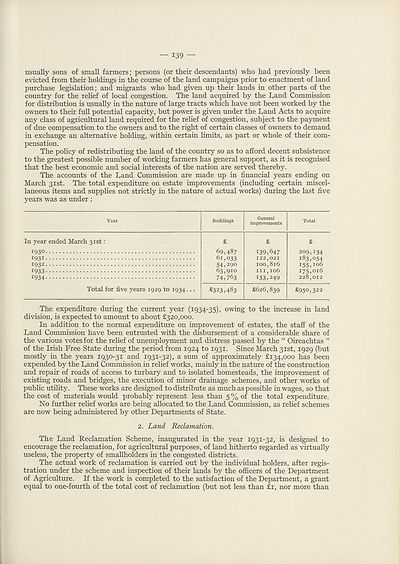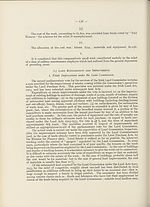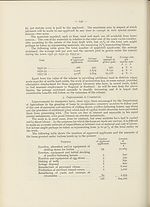Download files
Complete book:
Individual page:
Thumbnail gallery: Grid view | List view

139 —
usually sons of small farmers; persons (or their descendants) who had previously been
evicted from their holdings in the course of the land campaigns prior to enactment of land
purchase legislation; and migrants who had given up their lands in other parts of the
country for the relief of local congestion. The land acquired by the hand Commission
for distribution is usually in the nature of large tracts which have not been worked by the
owners to their full potential capacity, but power is given under the hand Acts to acquire
any class of agricultural land required for the relief of congestion, subject to the payment
of due compensation to the owners and to the right of certain classes of owners to demand
in exchange an alternative holding, within certain limits, as part or whole of their com¬
pensation.
The policy of redistributing the land of the country so as to afford decent subsistence
to the greatest possible number of working farmers has general support, as it is recognised
that the best economic and social interests of the nation are served thereby.
The accounts of the hand Commission are made up in financial years ending on
March 31st. The total expenditure on estate improvements (including certain miscel¬
laneous items and supplies not strictly in the nature of actual works) during the last five
years was as under :
The expenditure during the current year (1934-35), owing to the increase in land
division, is expected to amount to about £320,000.
In addition to the normal expenditure on improvement of estates, the staff of the
hand Commission have been entrusted with the disbursement of a considerable share of
the various votes for the relief of unemployment and distress passed by the “ Oireachtas ”
of the Irish Free State during the period from 1924 to 1931. Since March 31st, 1929 (but
mostly in the years 1930-31 and 1931-32), a sum of approximately £134,000 has been
expended by the hand Commission in relief works, mainly in the nature of the construction
and repair of roads of access to turbary and to isolated homesteads, the improvement of
existing roads and bridges, the execution of minor drainage schemes, and other works of
public utility. These works are designed to distribute as much as possible in wages, so that
the cost of materials would probably represent less than 5 % of the total expenditure.
No further relief works are being allocated to the hand Commission, as relief schemes
are now being administered by other Departments of State.
2. Land Reclamation.
The hand Reclamation Scheme, inaugurated in the year 1931-32, is designed to
encourage the reclamation, for agricultural purposes, of land hitherto regarded as virtually
useless, the property of smallholders in the congested districts.
The actual work of reclamation is carried out by the individual holders, after regis¬
tration under the scheme and inspection of their lands by the officers of the Department
of Agriculture. If the work is completed to the satisfaction of the Department, a grant
equal to one-fourth of the total cost of reclamation (but not less than £1, nor more than
usually sons of small farmers; persons (or their descendants) who had previously been
evicted from their holdings in the course of the land campaigns prior to enactment of land
purchase legislation; and migrants who had given up their lands in other parts of the
country for the relief of local congestion. The land acquired by the hand Commission
for distribution is usually in the nature of large tracts which have not been worked by the
owners to their full potential capacity, but power is given under the hand Acts to acquire
any class of agricultural land required for the relief of congestion, subject to the payment
of due compensation to the owners and to the right of certain classes of owners to demand
in exchange an alternative holding, within certain limits, as part or whole of their com¬
pensation.
The policy of redistributing the land of the country so as to afford decent subsistence
to the greatest possible number of working farmers has general support, as it is recognised
that the best economic and social interests of the nation are served thereby.
The accounts of the hand Commission are made up in financial years ending on
March 31st. The total expenditure on estate improvements (including certain miscel¬
laneous items and supplies not strictly in the nature of actual works) during the last five
years was as under :
The expenditure during the current year (1934-35), owing to the increase in land
division, is expected to amount to about £320,000.
In addition to the normal expenditure on improvement of estates, the staff of the
hand Commission have been entrusted with the disbursement of a considerable share of
the various votes for the relief of unemployment and distress passed by the “ Oireachtas ”
of the Irish Free State during the period from 1924 to 1931. Since March 31st, 1929 (but
mostly in the years 1930-31 and 1931-32), a sum of approximately £134,000 has been
expended by the hand Commission in relief works, mainly in the nature of the construction
and repair of roads of access to turbary and to isolated homesteads, the improvement of
existing roads and bridges, the execution of minor drainage schemes, and other works of
public utility. These works are designed to distribute as much as possible in wages, so that
the cost of materials would probably represent less than 5 % of the total expenditure.
No further relief works are being allocated to the hand Commission, as relief schemes
are now being administered by other Departments of State.
2. Land Reclamation.
The hand Reclamation Scheme, inaugurated in the year 1931-32, is designed to
encourage the reclamation, for agricultural purposes, of land hitherto regarded as virtually
useless, the property of smallholders in the congested districts.
The actual work of reclamation is carried out by the individual holders, after regis¬
tration under the scheme and inspection of their lands by the officers of the Department
of Agriculture. If the work is completed to the satisfaction of the Department, a grant
equal to one-fourth of the total cost of reclamation (but not less than £1, nor more than
Set display mode to:
![]() Universal Viewer |
Universal Viewer | ![]() Mirador |
Large image | Transcription
Mirador |
Large image | Transcription
Images and transcriptions on this page, including medium image downloads, may be used under the Creative Commons Attribution 4.0 International Licence unless otherwise stated. ![]()
| League of Nations > Communications and transit > Enquiry on national public works > (141) |
|---|
| Permanent URL | https://digital.nls.uk/195000183 |
|---|
| Shelfmark | LN.VIII |
|---|
| Description | Over 1,200 documents from the non-political organs of the League of Nations that dealt with health, disarmament, economic and financial matters for the duration of the League (1919-1945). Also online are statistical bulletins, essential facts, and an overview of the League by the first Secretary General, Sir Eric Drummond. These items are part of the Official Publications collection at the National Library of Scotland. |
|---|---|
| Additional NLS resources: |
|

